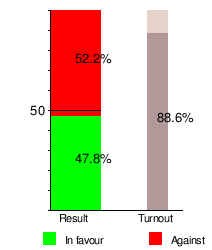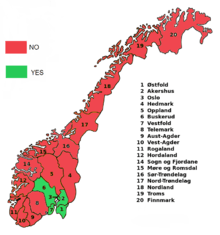Norwegian European Union membership referendum, 1994

 |
| This article is part of a series on the politics and government of Norway |
| Constitution |
|
Government |
|
Parliament
|
A referendum on joining the European Union was held in Norway on 27 and 28 November 1994.[1] After a long period of heated debate, the "no" side won with 52.2 per cent of the vote, on a turnout of 88.6 per cent. Membership of what was then the European Community had previously been rejected in a 1972 referendum, and by French Veto in 1962.
Campaign
The "No" campaign was led by Anne Enger Lahnstein, leader of the Centre Party.[2] The main themes of the "No" campaign were loss of sovereignty if Norway should join the Union, as well as the fundamental differences in economic structure between Norway and the EU, as Norway has an economy based heavily on natural resources (especially oil and fish), in contrast to the EU's more industrial economy.
Prime Minister Gro Harlem Brundtland led the "Yes" campaign. Her party, the Labour Party, was divided on the question of Norwegian membership of the Union. She refused to threaten to resign if the referendum failed to result in a "Yes" vote, on the grounds that more serious divisions could have arisen in the Labour Party. The main arguments of the "Yes" side were that as a European country, Norway belonged in the European Union, and that Norway's economy would benefit from membership.
Results
Countrywide
| Choice | Votes | % |
|---|---|---|
| |
1,516,803 | 52.2 |
| Yes | 1,389,997 | 47.8 |
| Valid votes | 2,906,750 | 99.9 |
| Invalid or blank votes | 3,571 | 0.1 |
| Total votes | 2,910,321 | 100.00 |
| Registered voters and turnout | 3,266,064 | 89.0 |
By constituency

| Constituency | Electorate | Spoilt votes | Total poll (%) | Yes (%) | No (%) | |||
|---|---|---|---|---|---|---|---|---|
| Østfold | 185,441 | 307 | 163,338 (88) | 87,390 (54) | 75,998 (46) | |||
| Akershus | 322,029 | 443 | 293,331 (91) | 187,126 (64) | 106,205 (36) | |||
| Oslo | 360,340 | 497 | 317,585 (88) | 211,550 (67) | 106,035 (33) | |||
| Hedmark | 146,468 | 215 | 129,674 (89) | 55,367 (43) | 74,307 (57) | |||
| Oppland | 142,911 | 251 | 126,245 (88) | 55,702 (44) | 70,543 (56) | |||
| Buskerud | 174,271 | 240 | 154,345 (89) | 88,281 (57) | 66,064 (43) | |||
| Vestfold | 155,338 | 123 | 138,099 (89) | 78,698 (57) | 59,401 (43) | |||
| Telemark | 125,401 | 106 | 110,136 (88) | 46,478 (42) | 63,658 (58) | |||
| Aust-Agder | 73,841 | 68 | 64,927 (88) | 28,805 (44) | 36,122 (56) | |||
| Vest-Agder | 108,226 | 58 | 96,318 (89) | 43,947 (46) | 52,371 (54) | |||
| Rogaland | 251,790 | 166 | 227,485 (90) | 103,066 (45) | 124,419 (55) | |||
| Hordaland | 313,511 | 244 | 281,543 (90) | 122,942 (44) | 158,601 (56) | |||
| Sogn og Fjordane | 80,104 | 52 | 71,650 (89) | 22,761 (32) | 48,889 (68) | |||
| Møre og Romsdal | 180,426 | 178 | 160,713 (89) | 61,715 (38) | 98,998 (62) | |||
| Sør-Trøndelag | 194,869 | 239 | 171,007 (88) | 77,035 (45) | 93,972 (55) | |||
| Nord-Trøndelag | 96,344 | 50 | 86,110 (89) | 31,018 (36) | 55,092 (64) | |||
| Nordland | 183,703 | 226 | 162,474 (88) | 46,394 (29) | 116,080 (71) | |||
| Troms | 113,840 | 57 | 101,428 (89) | 28,860 (28) | 72,568 (72) | |||
| Finnmark | 57,211 | 51 | 50,342 (88) | 12,862 (26) | 37,480 (74) | |||
| Source: Dataset European Election Database | ||||||||
See also
References
- ↑ Nohlen, D & Stöver, P (2010) Elections in Europe: A data handbook, p1438 ISBN 978-3-8329-5609-7
- ↑ Biography on Norwegian government's website (Norwegian)
- ↑ Folkeavstemningene om EU og EF. Fylkesvis Statistics Norway (Norwegian)
- ↑ Folkeavstemningen om EU Statistics Norway (Norwegian)
External links
- The European Movement in Norway
- No to the EU - Norwegian eurosceptics
- Norway. EU Referendum 1994, Electoral Geography 2.0 website